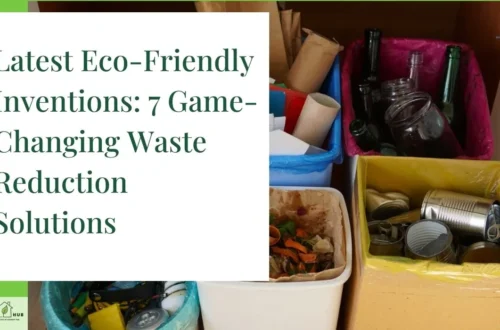13 Practical Ways to Go Green: Transform Your Lifestyle for a Sustainable Future

Sustainable living is about making choices that reduce your carbon footprint and protect our planet’s resources. It’s a lifestyle that considers the long-term impact of our daily decisions.
Think of it as being a good neighbor to the Earth. Just as you’d keep your music down to avoid disturbing your neighbors, sustainable living means being mindful of how your actions affect the environment.
For example, choosing to bike to work instead of driving doesn’t just save gas money. It also reduces air pollution and helps combat climate change.
Or consider your dinner plate. Opting for locally grown vegetables over imported fruits can significantly cut down on transportation emissions.
These small changes might seem insignificant, but they add up. When millions of people adopt a more sustainable lifestyle, the collective impact is enormous.
Remember, sustainable living isn’t about perfection. It’s about progress. Every step towards a greener lifestyle, no matter how small, is a step in the right direction.

Sustainable living involves making conscious choices in our daily lives to reduce our environmental impact and preserve resources for future generations.
The Environmental Impact of Our Daily Choices
Our everyday decisions have a bigger impact than we might think. From the coffee we drink to the clothes we wear, each choice contributes to our overall environmental footprint.
Take your morning routine, for instance. That steaming hot shower? It uses gallons of water and energy to heat it. Your coffee? If it’s not locally sourced, it might have traveled thousands of miles to reach your cup.
Even seemingly harmless activities like browsing the internet contribute to climate change through the energy used by data centers.
But it’s not all doom and gloom. Understanding these impacts empowers us to make better choices. For example, shortening your shower by just two minutes can save up to 10 gallons of water.
Choosing a plant-based milk for your coffee can reduce your carbon footprint. And using a search engine that plants trees can offset your digital carbon footprint.
Every action counts in the fight against climate change, air pollution, and water pollution. Your choices matter more than you might think.
Our daily habits and choices significantly impact the environment, from contributing to greenhouse gas emissions to affecting water and air quality.

RELATED: Understanding Eco Friendly and Environmentally Friendly
Benefits of Going Green
Embracing a greener lifestyle isn’t just good for the planet – it’s great for you too! Let’s explore some of the perks of making sustainable changes.
First off, going green often means saving green. Energy-efficient appliances and water-saving fixtures can significantly lower your utility bills.
Your health can benefit too. Walking or cycling instead of driving improves your fitness. Eating more plant-based foods can boost your nutrition.
Green living can also spark creativity. Finding new uses for old items or DIY-ing eco-friendly products can be fun and fulfilling.
Plus, there’s the feel-good factor. Knowing you’re doing your part for a more sustainable world can bring a sense of purpose and satisfaction.
And let’s not forget the biggest benefit – a healthier planet for future generations. Every sustainable change, no matter how small, contributes to this goal.
So, ready to reap these rewards? Let’s dive into some practical ways to go green!
Adopting a sustainable lifestyle offers numerous benefits, including financial savings, improved health, enhanced creativity, personal satisfaction, and a positive impact on the environment.
RELATED: Essential Traits of an Environmentally Conscious Individual: Transform Your Impact Today!
15 Practical Ways to Go Green
1. Reduce Energy Consumption
Cutting down on energy use is one of the easiest ways to go green. It’s like putting your home on an energy diet!
Start with your lighting. Swap out old bulbs for LED ones. They use up to 75% less energy and last way longer. It’s like getting a two-for-one deal on energy efficiency.
Next, tackle your appliances. Did you know that some devices suck energy even when they’re off? It’s called vampire power. Combat this by unplugging devices or using smart power strips.
Here’s a fun challenge: try a “no-power hour” once a week. Turn off everything non-essential and enjoy some candlelit family time or stargazing.
And don’t forget about your thermostat. Adjusting it just a few degrees can make a big difference. In winter, try wearing an extra layer instead of cranking up the heat.
Remember, every kilowatt-hour saved is a win for your wallet and the planet. So, get creative with your energy-saving tactics!
Reducing energy consumption through simple changes in lighting, appliance use, and temperature control can significantly lower your carbon footprint and energy bills.
RELATED: Master the 5 R’s: Ultimate Guide to Sustainable Living Beyond Reduce, Reuse, Recycle
2. Install Solar Panels
Ever dreamed of powering your home with sunshine? Solar panels make this a reality!
Installing solar panels is like giving your roof a superpower. They capture sunlight and convert it into electricity, reducing your reliance on fossil fuels.
While the upfront cost might seem high, think of it as an investment. Over time, the energy savings can really add up. Plus, many areas offer incentives for going solar.
Not ready for a full roof installation? Start small with solar-powered outdoor lights or a solar phone charger. It’s a great way to dip your toes into renewable energy.
Remember, every bit of solar power used is a step towards a cleaner, greener future. So why not let the sun work for you?
Solar panels offer a sustainable way to power your home, reducing reliance on fossil fuels and potentially saving money in the long run.
3. Upgrade to a Heat Pump
Think of a heat pump as a climate control ninja for your home. It can both heat and cool, making it a versatile energy-efficient option.
Unlike traditional heating systems that generate heat, a heat pump moves heat from one place to another. In winter, it pulls heat from the outside air (yes, even cold air has some heat!) and brings it inside. In summer, it does the reverse.
An air source heat pump is particularly efficient. It can be up to 300% efficient, meaning for every unit of electricity it uses, it can produce 3 units of heat!
Switching to a heat pump could significantly reduce your energy bills and carbon footprint. It’s like giving your home an eco-friendly makeover from the inside out.
Heat pumps, especially air source heat pumps, offer an energy-efficient alternative to traditional heating and cooling systems, potentially reducing both energy consumption and costs.
RELATED: Sustainable Lifestyle: 10 Easy Steps to Embrace Sustainable Living Today
4. Minimize Waste
Imagine if we treated waste like a game of Tetris, always trying to make everything fit perfectly with no gaps. That’s the mindset we need to minimize waste!
Start in your kitchen. Did you know the average family throws out about 25% of the food they buy? Combat food waste by meal planning, storing food properly, and getting creative with leftovers.
Next, tackle packaging. Bring reusable bags to the grocery store. Choose products with less packaging. It’s like playing a real-life version of “spot the difference”!
Don’t stop at the kitchen. Look for ways to reduce waste in every room. Use cloth napkins instead of paper. Opt for rechargeable batteries. Repair items instead of replacing them.
Remember, the goal isn’t to produce zero waste overnight. It’s about making small, consistent changes. Every plastic bag refused, every food scrap composted is a win for the planet.
Minimizing waste involves conscious efforts in all areas of life, from reducing food waste to choosing products with less packaging and embracing reusable alternatives.
5. Conserve Water
Water might cover 71% of our planet, but freshwater? That’s only 3%! Let’s treat it like the precious resource it is.
Start with the obvious: fix those leaky faucets. A drip a second wastes over 3,000 gallons a year! That’s like flushing your toilet 300 times for no reason.
In the bathroom, challenge yourself to take shorter showers. Use a timer and try to beat your record each time. It’s like a eco-friendly game show in your own home!
When brushing your teeth or shaving, turn off the tap. Running water while you brush wastes up to 4 gallons each time!
In the garden, water early in the morning or late in the evening to reduce evaporation. Better yet, collect rainwater for your plants. They’ll love the natural, chlorine-free drink!
And here’s a cool trick: place a bottle filled with water in your toilet tank. It reduces the amount of water used per flush without affecting performance.
Remember, every drop saved counts. Be a water superhero in your home!
Water conservation can be achieved through simple daily habits like fixing leaks, taking shorter showers, and being mindful of water use in various household activities.
6. Adopt Sustainable Transportation
Ready to give your car a break? Your wallet, your health, and the planet will thank you!
Public transportation is like a magic carpet ride for the environment. A full bus can take 40 cars off the road! Imagine the reduction in fossil fuel use and air pollution.
For shorter trips, why not bike or walk? It’s like hitting two birds with one stone – you get exercise and reduce your carbon footprint. Plus, you might discover hidden gems in your neighborhood!
If you must drive, consider carpooling. It’s like a mini-party on wheels that’s good for the environment. Or look into electric or hybrid vehicles. They’re the superheroes of the car world, fighting against the burning of gasoline.
Remember, every mile not driven in a gas-guzzler is a win for cleaner air. So, next time you’re heading out, ask yourself: “What’s the greenest way to get there?”
Opting for sustainable transportation methods like public transit, biking, or walking can significantly reduce individual carbon footprints and contribute to cleaner air.
RELATED: 15 Powerful Ways to Become a Conscious Consumer
7. Embrace Plant-Based Eating
Ever thought about giving your plate a green makeover? Plant-based eating is like a superpower for the planet!
Switching to more plant-based foods can drastically reduce your carbon footprint. Did you know that producing a pound of beef creates 30 times more greenhouse gases than producing a pound of lentils?
But don’t worry, you don’t have to go full vegan overnight. Start small. Try “Meatless Mondays” or swap your regular milk for a plant-based alternative in your morning coffee.
Experiment with new types of vegetables. Ever tried jackfruit tacos or cauliflower steaks? You might discover your new favorite dish!
And here’s a fun fact: many cultures around the world have traditionally eaten mostly plant-based diets. So, by eating more plants, you’re not just helping the planet – you’re exploring global cuisines!
Remember, every plant-based meal is a win for the environment. So, why not challenge yourself to try a new veggie recipe this week?
Incorporating more plant-based foods into your diet can significantly reduce your environmental impact while offering opportunities to explore diverse and delicious cuisines.
8. Shop Local and Seasonal
Imagine your food’s journey to your plate. The shorter that journey, the better for the planet!
Shopping local is like giving a high-five to your community and the environment. When you buy from local farmers, you’re reducing the distance your food travels, which means less fuel used and fewer greenhouse gases emitted.
Seasonal eating is nature’s way of providing variety. It’s like Earth’s own rotating menu! In spring, enjoy fresh asparagus. In summer, savor juicy tomatoes. Fall brings hearty squashes, while winter offers crisp apples.
Next time you’re at the grocery store, look for signs indicating local produce. Or better yet, visit a farmers market. It’s like a treasure hunt for the freshest, most sustainable goodies!
And here’s a fun idea: try growing some of your own food. Even a small herb garden on your windowsill can make a difference. Plus, there’s nothing quite like the taste of home-grown basil in your pasta!
Remember, every local, seasonal item you choose is a vote for a more sustainable food system. So, let’s eat with the seasons and support our local farmers!
Choosing local and seasonal produce reduces transportation emissions, supports local economies, and provides fresher, more varied food options throughout the year.
RELATED: How Can you Be More Sustainable?
9. Choose Eco-Friendly Products
Shopping with the planet in mind? It’s easier than you might think!
Start in your bathroom. Many conventional brand-name products of shampoo, soaps, and cosmetics contain harmful chemicals. Look for natural, biodegradable alternatives. It’s like giving your body and the environment a spa day!
In the cleaning aisle, opt for products free from harsh chemicals. Vinegar and baking soda can tackle most cleaning jobs. It’s like being a green cleaning superhero!
When it comes to pest control, avoid products with toxic pesticides. Instead, try natural deterrents or integrated pest management. It’s safer for you, your pets, and the environment.
And don’t forget about packaging. Choose products with minimal or recyclable packaging. It’s like a game of “spot the most eco-friendly product” every time you shop!
Remember, every eco-friendly product you choose is a step towards a cleaner, greener world. So, next time you’re shopping, ask yourself: “What would Mother Nature buy?”
Opting for eco-friendly products with natural ingredients and minimal packaging reduces exposure to harmful chemicals and minimizes waste, benefiting both personal health and the environment.
10. Reduce Single-Use Plastics
Imagine if every piece of plastic ever made still existed. Well, it does! Let’s break up with single-use plastics.
Start with the obvious: ditch the plastic water bottles. A reusable water bottle is like a superhero sidekick in your fight against plastic waste. It goes everywhere with you, saving countless single-use bottles from landfills.
At the grocery store, bring your own bags. It’s like a fashion statement that says, “I care about the planet!” Don’t forget smaller reusable bags for produce too.
In the kitchen, swap plastic wrap for beeswax wraps or silicone covers. They’re like colorful, eco-friendly hats for your leftovers!
When ordering takeout, say no to plastic cutlery. Bring your own or use what you have at home. It’s like giving plastic the cold shoulder.
Remember, every piece of single-use plastic avoided is a win for our oceans and wildlife. So, let’s make “reduce, reuse, recycle” our new mantra!
Reducing single-use plastics through simple swaps like reusable water bottles and shopping bags can significantly decrease plastic waste and its environmental impact.
11. Practice Responsible Fashion Choices
Did you know the fashion industry is one of the most environmentally destructive industries? Let’s dress to impress – the planet, that is!
First, slow down your fashion consumption. The average person buys 60% more clothing items per year than 15 years ago. Before buying, ask yourself: “Do I really need this?” It’s like putting your wardrobe on a healthy diet!
When you do shop, choose quality over quantity. A well-made item that lasts for years is better than several cheap pieces that wear out quickly. It’s like investing in a classic car instead of leasing a new one every year.
Look for eco-friendly fabrics like organic cotton, hemp, or recycled materials. It’s like dressing in nature’s finest!
Don’t forget about secondhand shopping. Thrift stores and online resale platforms are treasure troves of unique finds. It’s like a fashion scavenger hunt!
And when you’re done with clothes, donate or recycle them. Many brands now have take-back programs. It’s like giving your clothes a second life!
Remember, every sustainable fashion choice you make helps combat the environmental impact of fast fashion. So, let’s make our wardrobes as green as our lifestyles!
Responsible fashion choices, including buying less, choosing quality items, opting for eco-friendly fabrics, and embracing secondhand shopping, can significantly reduce the environmental impact of clothing consumption.
RELATED: Practical Steps to Eco Friendly Living: Your Ultimate Guide to a Greener Lifestyle
12. Improve Home Energy Efficiency
Turning your home into an energy-saving powerhouse doesn’t have to be complicated. It’s all about small energy efficiency measures that add up to big savings!
Start with your windows. Drafty windows can account for up to 30% of your heating and cooling costs. Seal them up with weatherstripping or caulk. It’s like giving your home a cozy sweater!
Next, look at your appliances. Energy-efficient models might cost more upfront, but they’ll save you money in the long run. It’s like investing in a piggy bank that fills itself!
Don’t forget about your lightbulbs. LED bulbs use up to 90% less energy than traditional incandescent bulbs. Switching is like putting your lights on an energy diet!
Here’s a fun fact: the average UK household could save £40 a year just by turning appliances off standby. That’s enough for a nice dinner out!
Remember, every watt saved is a win for your wallet and the planet. So, let’s make energy efficiency a household game. Who can remember to turn off lights the most? Who can take the shortest shower? Make it fun!
Implementing small energy efficiency measures throughout your home, from sealing windows to using energy-efficient appliances, can lead to significant energy and cost savings over time.
13. Support Sustainable Businesses
Your money is like a vote for the kind of world you want to live in. Why not use it to support businesses that care about the planet?
Start with your bank account. Some banks invest heavily in fossil fuels. Consider switching to a bank with strong environmental policies. It’s like your money is taking a stand for clean energy!
When shopping, choose products from companies that prioritize sustainability. Look for certifications like Fair Trade, Organic, or B Corp. It’s like shopping with a conscience!
Support local businesses that value eco-friendly practices. Buying local reduces transportation emissions and supports your community. It’s like giving back to the neighborhood!
Consider the longevity and recyclability of products before making a purchase. Opt for items that are built to last or have minimal impact when disposed of. It’s like investing in a better future!
Lastly, spread the word about sustainable businesses to friends and family. Your recommendations can inspire others to make eco-conscious choices as well. It’s like planting seeds of change!
Remember, every dollar spent at a sustainable business is a positive contribution towards a greener, more ethical economy. So, let’s use our purchasing power to shift towards a more sustainable world together!
Supporting sustainable businesses through conscious consumer choices can drive positive environmental and social change while promoting a more ethical economy.
Conclusion
As we wrap up our journey through these 13 practical ways to go green, it’s clear that sustainable living is not just a trend, but a necessity for our planet’s future. By implementing these changes, from reducing energy consumption to embracing the 3 R’s, we can significantly decrease our carbon footprint and contribute to a more sustainable world.
Remember, every small action counts. Whether it’s using a reusable water bottle, taking shorter showers, or supporting local businesses, these choices add up to create a substantial positive impact. The path to sustainability may seem challenging, but the benefits for our environment, health, and future generations are immeasurable.
Let’s embrace this opportunity to be stewards of our incredible planet. By working together and making conscious decisions in our daily lives, we can pave the way for a greener, cleaner, and more sustainable future. Thank you for taking the time to explore these eco-friendly tips. Now, it’s time to take action and start your green journey today!





